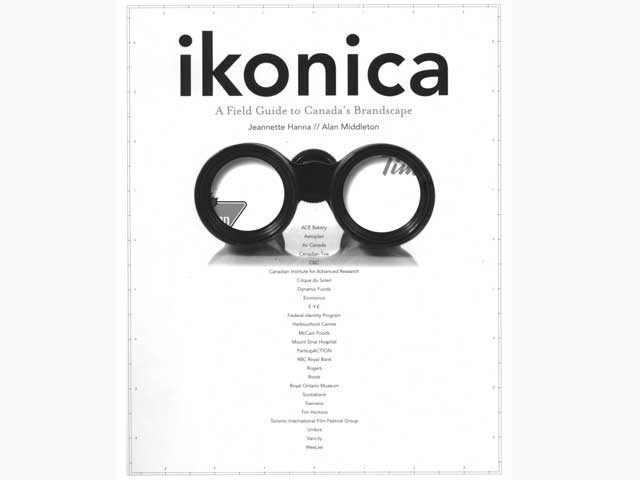ikonica: A Field Guide to Canada’s Brandscape
Jeanette Hanna and Alan Middleton
Douglas & Mcintyre
232 pages
Brands are like insignia. If you wear the Nike swoosh on your chest, then you’re making something of a declaration. Same goes for posting the ad spoof postcards that come with a subscription to Adbusters — although the latter is a little more ironic. Point is, most people hoist these flags with the intent of announcing some or all of their identity. It’s often about associating yourself with a value system, and then using a symbol to communicate that lifestyle to people around you. That’s a dialogue, and, whether or not it’s consciously engaged, people do it all the time.
If you think of North America’s more prominent brands, odds are you’ll conjure an image with American roots, anything from an iPod to a Ford. ikonica: A Field Guide to Canada’s Brandscape explores Canada’s contribution to corporate and cultural branding. Written by Jeanette Hanna and Alan Middleton, it explains the national brandscape as a sort of uniform we collectively and often obliviously wear in the global community.
It begins with an essay on semiotics, which is basically the study of symbols and their meaning. Every culture is loaded with symbolic rallying points, and they’re usually so ubiquitous that it takes a foreigner to actively notice them. Our national character, a brand itself, sets out the way we produce, propel and mingle with these symbols.
The brandscape in Canada, like the country’s geography, is vast and varied. Obvious icons like Tim Hortons are so indelible that they’re basically institutions. Through persistent marketing and near viral franchising, Tim Hortons has fashioned itself as a living room away from home, a place where family and friends can blend views and enrich their relationships; that its namesake was a hockey player certainly doesn’t hurt.
According to the authors, the Canadian values that favour modesty and resist excessive individuality have subverted the history of our brands. Their case in point is the Blackberry, one of Canada’s corporate success stories that has yet to be told in hardcover. Instead, we focus on Conrad Black’s plunge from the ivory tower, likely because his hubris and eccentricity offends our national sensibilities.
And that’s where ikonica goes wrong. It’s almost the antithesis to Naomi Klien’s No Logo , which was blind to its own dogma and steeped in enough irony to constitute hypocrisy. No Logo , after all, is every bit a brand, complete with value system and lifestyle. It’s just a countercultural version of those notions, and counterculture has been an industry at least since the Beach Boys.
Whereas No Logo ideologically crusaded against branding, ikonica cuddles it with blinders. The authors lovingly trace the birth of North American branding to the Hudson Bay Company, which dates back to the mid 17 th century. Europe’s petty love affair with beaver skin hats sent traders into Canada and helped set off the colonial experience that brought so much misery to aboriginals. It probably would’ve happened anyway: the thirst for natural resources preceded ideological imperialism in Africa and South America, too, but to celebrate it, especially under the auspices of fashion, is hard to swallow.
Harder still to swallow is the book’s exploration of Canadian identity — of our national brand — which falls into the common trap of using Americans as a counterpoint, and doing so based on stereotype. Americans are self-obsessed and bloated with ego; therefore Canadians are not. Americans are war mongering; therefore we’re not. A lot of the time, stereotypes find their basis in reality. Still, they’re distortions, and attempting to sketch a national character based on stereotype is an exercise in futility.
At the same time — and much like No Logo — there’s value in ikonica . With essays by the CBC’s John Buzzo, Environic’s Michael Adams and a slew of other brand leaders, it does offer insights the daily business sections can’t manage. And there’s enough ownership information to track brands and subsidiaries to their core, which is usually a pretty heavy research endeavour.
A crusader wrote No Logo . Two crusaders wrote ikonica . Between the two books lies an even ground from which a deeper understanding of brands and their societal implications can be gained.


.png;w=120;h=80;mode=crop)

